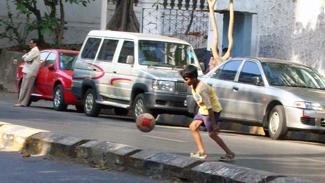When it comes to improving road safety, working in partnership can go a long way. This is the case of the on-going collaboration between the World Bank and Bloomberg Philanthropies on increasing road safety in developing countries.
Over the past four years both organizations, along with governments and other partners, have focused efforts on strengthening legislation, providing training on advocacy, post-crash care, enforcement, and improving road infrastructure. This joint work has led to some initial and important results, particularly on strengthening legislation and enforcement to effect behavior change.
In Hyderabad, India, for example, there was a 75 percent reduction in drunk driving from 2011 to 2013. In Dalian, China, speeding was reduced by 80 percent over the period 2011-13. And helmet use improved by 100 percent in Ha Nam, Vietnam, over the same period.
All these are examples of effective collaboration on the ground between global partners, local governments and communities.
Bloomberg Philanthropies recently announced the new phase of its Global Road Safety Initiative, which will focus on five low and middle-income countries and 10 major cities, in partnership with the World Bank-led Global Road Safety Facility and other organizations. Bloomberg is committing $125 million over five years to strengthen road safety legislation and implementing proven road safety interventions.
“We applaud Bloomberg’s strong commitment to improving road safety, and we look forward to jointly achieving more results that save precious lives,” said Pierre Guislain, senior director of the World Bank’s Transport and ICT Global Practice. “The UN Decade of Action on Road Safety is almost halfway through — and it is critical to scale up resources and efforts for greater impact.”
The selections were made from a pool of 20 strong applicant cities around the world. The five countries selected include China, India, Philippines, Thailand and Tanzania. The ten cities, which span other countries, include: Accra; Addis Ababa; Bandung; Bangkok; Bogota; Fortaleza; Ho Chi Minh; Mumbai; São Paulo; and Shanghai.
The selected city authorities will receive support for in-house staff to work on the proposed road safety initiatives; along with comprehensive technical assistance; training for police officers; and support to create hard-hitting media campaigns.
Decisive action
With assistance from the world’s leading experts in road safety, winning cities will establish an elite network of visionary municipal leaders who commit to implementing bold, new efforts to save lives and protect their citizens from road traffic injuries.
“We can prevent millions of road traffic fatalities and injuries through stronger laws, more effective enforcement and better infrastructure,” said Michael R. Bloomberg, founder of Bloomberg Philanthropies and three-term mayor of New York City. “Road traffic deaths will become increasingly common in the years ahead, unless we take decisive action now to prevent them.”
More than 1.2 million people die and some 50 million people are severely injured from road traffic crashes around the world every year.
From the inception of the World Bank-led Global Road Safety Facility in 2006, road safety lending has almost tripled to some US$1 billion dollars over the past nine years (FY06-14) compared to US$358 million for the previous FY97-05.
The World Bank estimates that costs of road-related fatalities range on average from two to five percent of GDP in each of these developing countries. However, the cost to a family in losing a loved one is enormous, both in terms of emotional trauma and loss of income, or caused disability, especially when poor countries do not have enough safety nets for the road crash victims.
Since the socio-economic impact of these losses affects the most vulnerable groups in low and middle-income countries, the World Bank and its partners are scaling up efforts on road safety by adopting a multi-sectoral approach and mainstreaming road safety components into transport projects.
Results to date
The World Bank follows a Safe Systems principle for road safety, which is a holistic approach that looks at all components of an effective road safety policy: institutions, infrastructure, behavior, enforcement, and post-crash care.
A few examples of achievements by the World Bank-led Global Road Safety Facility and other partners over the past few years include:
- Technical assistance and advisory services to various governments in Africa (i.e. Nigeria, Ghana) to facilitate the establishment of relevant regulatory frameworks and policies, including well-funded and functioning road safety agencies;
- The development and transformation of road assessment programs, for example in China, into self-sustaining entities capable of not only supporting domestic programs, but also other countries;
- The assessment of more than 40,000 of kilometers of roads for stronger safety measures in various countries, including the Philippines, India, Brazil and others;
- The establishment of a regional road safety observatory in Latin America to improve data collection, along with capacity building in more than 20 countries; and the replication of similar work in the Pacific Islands;
- The improvement of safety awareness amongst children and youth in Mengzi City (China) to reduce risky traffic behaviors and the occurrence of traffic injuries, deaths and disabilities on school roads;
- The development of schools’ safety zones in Kerala state (India) along transport corridors, with emphasis on demarcated safety zones around school perimeters and safeguarding infrastructure to protect children and other vulnerable users.

